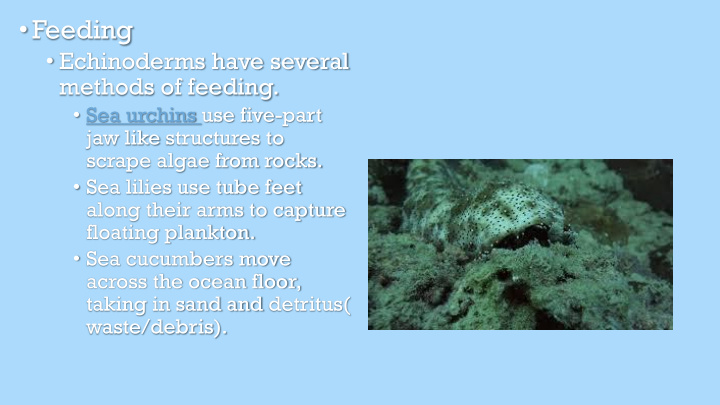



• Feeding • Echinoderms have several methods of feeding. • Sea urchins use five-part jaw like structures to scrape algae from rocks. • Sea lilies use tube feet along their arms to capture floating plankton. • Sea cucumbers move across the ocean floor, taking in sand and detritus( waste/debris).
• Sea stars usually feed on mollusks such as clams and mussels using tube feet to open shell. • Once open the sea star pushes out its stomach out of mouth • Pours out digestive enzymes and the sea star starts digesting the mollusk in its own shell. • Pulls its stomach/partially digested prey back into mouth.
RESPIRATION AND CIRCULATION • In most echinoderms, the thin- walled tissue of the tube feet provides the main surface for respiration. • In some species, small outgrowths called skin gills also function in gas exchange. • Circulation of oxygen, food and wastes takes place by the water vascular system.
EXCRETION • Excretion • Digestive wastes are released as feces through the anus. • Nitrogen-containing cellular wastes are excreted primarily in the form of ammonia. • This waste is passed into surrounding water through the thin walled tissues of tube feet and skin gills.
RESPONSE • Response • Most echinoderms have a nerve ring • surrounds the mouth • radial nerves that connect the ring with the body sections. • Most echinoderms have scattered sensory cells that detect • Light • Gravity • Chemicals released by potential prey.
MOVEMENT • Movement • Most echinoderms move using tube feet. • Sand dollars and sea urchins have movable spines attached to the endoskeleton. • Sea stars and brittle stars use their arms for locomotion. • Sea cucumbers crawl by using both tube feet and the muscles of their body wall. • Feather stars
FORM AND FUNCTION IN ECHINODERMS • Reproduction • Echinoderms reproduce by external fertilization. • Both sperm and eggs are shed into open water, where fertilization takes place. • The larvae swim around for some time. • Larvae then swim to the ocean bottom and develop into adults.
Recommend
More recommend